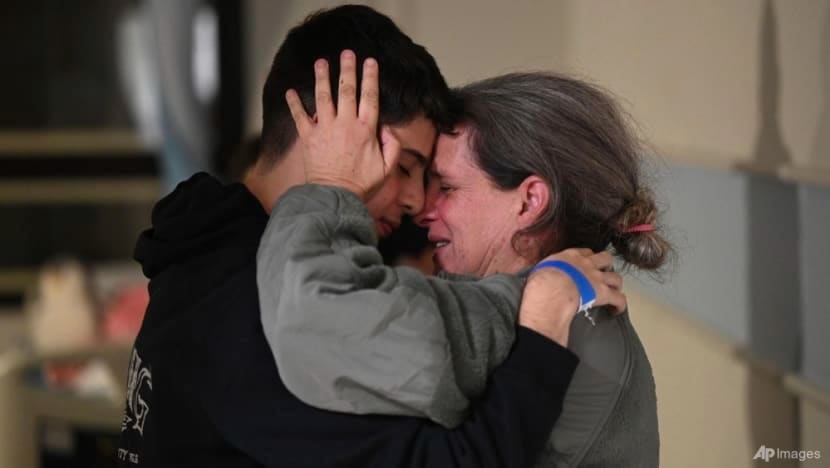A week-long truce, over 100 hostages freed: The fragile Israel-Hamas deal that collapsed
By the end of the seven-day truce, a total of 105 hostages had been released by Hamas in return for 240 Palestinians.

A series of hostage swaps took place in the first three days of the truce. (Photo: Handout via AP/GPO/Haim Zach)

This audio is generated by an AI tool.
After a highly anticipated truce and two last-minute extensions, the world watched as the clock ticked down to the scheduled end of the Israel-Hamas ceasefire on Friday (Dec 1).
There were hopes of yet another extension of the deal for hostage and prisoner exchanges.
But fighting took place in the hour before the truce was due to end. After the fragile deal expired, the first fatalities were reported soon after.
Apart from the release of hostages and prisoners, the truce agreement had also allowed aid agencies to increase their deliveries of essential supplies to Gaza's people.
CNA takes a look at developments in the last week and what could be expected next.
HOSTAGES RELEASED
The initial terms of the deal, which started as a four-day truce on Nov 24, was that 50 women and children would be freed in exchange for 150 Palestinians held captive by Israel.
These figures rose with the continued pause in fighting.
By the end of the seven-day truce, a total of 105 hostages - 80 of them Israelis - had been released by Hamas in return for 240 Palestinians.
The hostages freed include 23 Thai citizens released in a parallel deal. At least 32 Thais were abducted by Hamas, with Bangkok's foreign ministry and Thai Muslim groups working to negotiate their release.
Abigail Edan, a four-year-old Israeli-American hostage whose parents were killed in the Oct 7 Hamas attack, was among the children released.
As the hostage deal came to an end, the last batch of eight Israelis released included 21-year-old Mia Schem, who was among those seized at a dance party.
Also released were siblings Belal and Aisha al-Ziadna, aged 18 and 17 respectively, according to the Israeli Prime Minister's Office.
They were among four members of their family taken hostage while they were milking cows on a farm.
The truce also provided the heavily sieged areas of the West Bank momentary relief as Palestinian families were reunited.
Rouba Assi, a 23-year-old activist, fell into her friends' arms after being freed from an Israeli prison on Nov 28.
The last batch of 30 Palestinians were released from jails on Thursday, said the Israeli prison service.
LAST-MINUTE EXTENSIONS
The truce was extended twice.
On Nov 27, mediator Qatar announced that the ceasefire had been prolonged for two more days and was then scheduled to end on Nov 30.
Then on the last day of the extended truce, Israel and Hamas were able to strike a last-minute agreement for one more day, bringing the ceasefire to seven days.
Listen:
Qatar and Egypt have played a crucial role in mediation efforts.
The Qatari government's role as a third-party mediator goes back many years, exercising its diplomatic abilities since the 1990s and has become an important aspect of its foreign policy.
Despite the resumption of fighting, talks between Qatari and Egyptian mediators were "ongoing", said a source briefed on the talks. According to Egypt's official state media agency, the mediators were working to negotiate a further extension of two days.
With fewer Israeli women and children left in captivity, extending the truce could require setting new terms for the release of Israeli men, including soldiers, reported Reuters.
One of Qatar's lead negotiators, career diplomat Abdullah Al Sulaiti who helped broker the truce through marathon shuttle negotiations, acknowledged in a recent interview with Reuters the uncertain odds of maintaining the ceasefire.
"At the beginning, I thought achieving an agreement would be the most difficult step," he said in an article that detailed the behind-the-scenes mediation efforts.
"I've discovered that sustaining the agreement itself is equally challenging."
AID STILL FAR BELOW WHAT IS NEEDED
The truce had allowed some humanitarian aid into Gaza after much of the coastal territory of 2.3 million people was reduced to wasteland in the Israeli assault.
More fuel and 56 trucks of humanitarian supplies entered Gaza on Thursday, according to Israel's defence ministry and the Palestinian Red Crescent Society.
But aid workers said food, water, medical supplies and fuel remain far below what is needed.
United Nations Secretary-General Antonio Guterres said on Wednesday that the level of aid "remains completely inadequate to meet the huge needs".
"The people of Gaza are in the midst of an epic humanitarian catastrophe before the eyes of the world," he added. "We must not look away."
James Elder from UNICEF - the United Nations International Children's Emergency Fund - took part in a five-truck convoy on Nov 26 delivering food and medical kits, and described seeing injured children lying in hospital beds.
"They look like they'd been broken and then badly put back together," he said.
"It seems callous and cold to think that we may be getting to the end of those deliveries and hostilities will continue, (that) the war, this war on children will continue."
SHORTLIVED PAUSE IN FIGHTING
The truce had allowed people to return to the ruins of their homes to pick through the rubble for remaining belongings and provided a sense of safety after seven weeks of daily bombardment.
Gaza residents said the deal allowed them a moment of respite.
"We’re living days of calm, where we are stealing moments to make tea," said Ibrahim Kaninch, his face lit in warm colours by the glow of the fire.
"These truce days have allowed people to have a bit of social communication and to check on their families and friends and their houses."
As combat resumed between Israel and Hamas, Gazans were once again fleeing their homes.
















